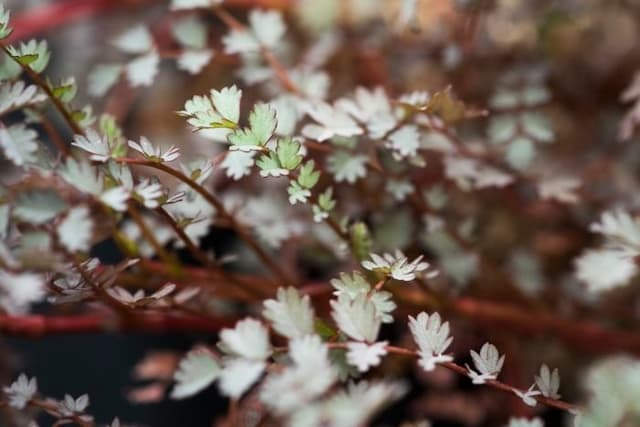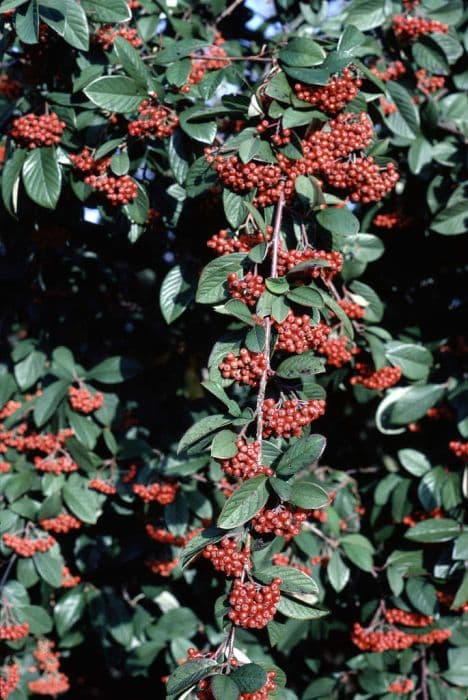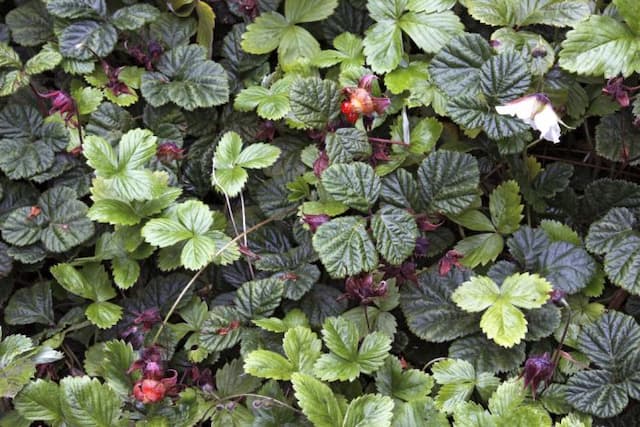Indian Hawthorn Rhaphiolepis × delacourii Enchantress = 'Moness'
![Indian hawthorn [Enchantress]](/_next/image?url=https%3A%2F%2Fplants-admin.emdemapps.com%2Fimages%2Fplants%2F%2Fimages%2F604b5eefbd4f1.png&w=3840&q=75)
ABOUT
Rhaphiolepis × delacourii Enchantress, commonly known as Indian Hawthorn 'Enchantress', is an evergreen shrub that exhibits a dense, rounded, and compact habit. The plant's foliage consists of glossy, dark green leaves that are leathery to the touch. These leaves can also show hints of bronze coloring, especially when new growth emerges in the spring. The Indian Hawthorn 'Enchantress' is well-known for its showy clusters of flowers. The blossoms are typically pink, starting out as deeper pink buds before opening into pale pink or almost white flowers with a light, delicate fragrance. These flowers are star-shaped and bloom in abundance, covering the shrub and providing a stunning and attractive display. As the flowering season ends, the Indian Hawthorn 'Enchantress' develops ornamental fruits. These fruits are small, starting green and transitioning to a deep, dark blue or black as they mature. The fruits can add visual interest to the landscape throughout the fall and sometimes into the winter, depending on the climate. The plant's attractive appearance and the year-round interest it provides with its foliage, flowers, and fruit make it a favored choice for gardeners looking to add structure and color to their landscapes.
About this plant
 Names
NamesFamily
Rosaceae.
Synonyms
Indian Hawthorn, Enchantress Fairy Hawthorn, Delacour's Yeddo Hawthorn.
Common names
Rhaphiolepis × delacourii 'Moness'
 Toxicity
ToxicityTo humans
Indian Hawthorn is not widely known for being toxic to humans. There is limited information suggesting any significant risk associated with accidental ingestion. However, like with any plant that isn't typically consumed, individual sensitivities could potentially cause mild stomach upset or an allergic reaction. It is always best to avoid eating any part of ornamental plants unless they are specifically grown for consumption.
To pets
Indian Hawthorn can cause mild to moderate digestive upset in pets if ingested. The symptoms might include vomiting, diarrhea, and in some cases, an animal could experience an allergic reaction. While not considered highly toxic, ingestion of significant quantities should be avoided, and if symptoms arise, consultation with a veterinarian is advisable.
 Characteristics
CharacteristicsLife cycle
Perennials
Foliage type
Evergreen
Color of leaves
Dark green
Flower color
Pink
Height
2-3 feet (0.6-0.9 meters)
Spread
2-4 feet (0.6-1.2 meters)
Plant type
Shrub
Hardiness zones
7
Native area
Hybrid origin
Benefits
 General Benefits
General Benefits- Low Maintenance: Rhaphiolepis 'Enchantress' is known for its easy care and low maintenance requirements, making it ideal for gardeners of all skill levels.
- Drought Tolerance: Once established, it is drought-tolerant, reducing the need for frequent watering.
- Attracts Wildlife: Produces flowers that can attract bees, butterflies, and other pollinating insects, enhancing biodiversity.
- Long Blooming: Offers a lengthy blooming season, providing showy flowers that enhance the aesthetic appeal of landscapes.
- Disease and Pest Resistance: Exhibits a natural resistance to many common pests and diseases, reducing the need for chemical treatments.
- Erosion Control: Its root system can help prevent soil erosion, especially when planted on slopes or in areas prone to erosion.
- Hardiness: It is adaptable to a variety of climates and can withstand cold temperatures once established.
- Evergreen: As an evergreen shrub, it provides year-round foliage, keeping landscapes looking vibrant even in cooler months.
- Versatility: Suitable for a range of landscape applications, including hedges, borders, and specimen plantings.
- Compact Size: Its naturally compact growth habit makes it ideal for smaller gardens or spaces where a massive plant would be inappropriate.
 Medical Properties
Medical PropertiesThis plant is not used for medical purposes.
 Air-purifying Qualities
Air-purifying QualitiesThis plant is not specifically known for air purifying qualities.
 Other Uses
Other Uses- Rhaphiolepis Enchantress can be used in dried floral arrangements, where its small, attractive flowers contribute an enduring element to the composition.
- The dense foliage of the Enchantress makes it a good option for topiary or shaped hedges in ornamental gardening, offering a structured aesthetic.
- Some artisans use the branches and foliage as a natural dye source for fabrics, providing a subtle green hue.
- The tough, leathery leaves can be utilized in crafts, such as creating impressions in clay or plaster for decorative purposes.
- Enchantress is suitable for bonsai creation, with its slow growth rate and ability to adapt to pruning and shaping.
- The flowers can be used to make festive garlands or wreaths for seasonal decorations, especially in springtime events.
- When fallen, the leaves can serve as a natural mulch, helping to retain soil moisture and suppress weed growth in garden beds.
- Its branches can be incorporated into habitat restoration projects, particularly in urban settings where robust plants are needed.
- The flowers supply nectar, which can be a food source for bees and butterflies in gardens focused on supporting pollinators.
- When used in landscape design, Rhaphiolepis Enchantress can provide erosion control on slopes due to its dense rooting habit.
Interesting Facts
 Feng Shui
Feng ShuiThe Indian Hawthorn is not used in Feng Shui practice.
 Zodiac Sign Compitability
Zodiac Sign CompitabilityThe Indian Hawthorn is not used in astrology practice.
 Plant Symbolism
Plant Symbolism- Resilience: This hybrid plant Rhaphiolepis 'Enchantress' is known for its toughness and ability to thrive in various conditions, symbolizing the strength to endure and prosper.
- Charm and Attraction: With "Enchantress" in its name, this plant is often connected to notions of allure and beauty, representing the power of attractiveness and charm.
- Hope: The 'Moness' variety, with its vibrant flowers, can stand for hope and the anticipation of joy and positivity, much like the way flowers signal the coming of spring after winter.
- Renewal: The perennial nature of the Rhaphiolepis signifies renewal and the continuous cycle of growth and rebirth.
- New Beginnings: The blooming of this plant can signify starting fresh or embarking on new ventures, much as plants represent the start of new life.
 Water
WaterThe Indian Hawthorn should be watered thoroughly, allowing the soil to dry out slightly between waterings. A general guideline is to water every 7 to 10 days, depending on the weather and soil conditions. Deep watering is preferable, ensuring that the water reaches the root zone, which may require approximately 1 to 2 gallons for each plant during each watering session. During the active growing season in spring and summer, the frequency may increase, while in winter, it may decrease.
 Light
LightIndian Hawthorn thrives in full sun to partial shade. The ideal location for this plant is a spot where it receives at least six hours of direct sunlight daily. However, it can also tolerate light shade, especially in areas with hot afternoon sun.
 Temperature
TemperatureIndian Hawthorn prefers a temperate climate and can survive temperature ranges from about 0 to 85 degrees Fahrenheit, but it thrives best when temperatures are between 60 and 80 degrees Fahrenheit. It can endure occasional cold snaps down to about 10 degrees Fahrenheit but should be protected from prolonged freezing temperatures.
 Pruning
PruningIndian Hawthorn should be pruned to maintain shape and encourage bushier growth, generally after it has finished blooming in spring. Removing dead or damaged branches can be done at any time. Pruning once a year is typically sufficient, but some gardeners may prune lightly again in late summer to shape the plant if needed.
 Cleaning
CleaningAs needed
 Soil
SoilIndian Hawthorn 'Moness' thrives in a well-draining soil mix with a slightly acidic to neutral pH, typically around 6.0 to 7.0. A good soil mix would contain 2 parts loam, 1 part sand, and 1 part peat or organic compost to ensure proper drainage and fertility.
 Repotting
RepottingIndian Hawthorn 'Moness' does not require frequent repotting; it can be done every 2 to 3 years or when the plant outgrows its current pot. Ensure good drainage in the new pot and use fresh soil mix.
 Humidity & Misting
Humidity & MistingIndian Hawthorn 'Moness' prefers moderate humidity levels, similar to typical outdoor conditions. It does not require high humidity, making it quite adaptable to average home or garden environments.
 Suitable locations
Suitable locationsIndoor
Place Indian Hawthorn 'Moness' in bright, indirect light.
Outdoor
Plant Indian Hawthorn 'Moness' in full sun to part shade.
Hardiness zone
7-10 USDA
 Life cycle
Life cycleRhaphiolepis 'Enchantress' commonly known as the Indian Hawthorn, begins its life cycle with seed germination when environmental conditions are ideal, typically in warm, moist soil. Seedlings emerge and establish a root system, followed by the development of juvenile foliage. As the plant matures, it enters a vegetative state, during which it develops into a dense shrub with glossy green leaves through a period of active growth. It then progresses to the flowering stage, producing fragrant, pinkish-white flowers that attract pollinators during late winter to early spring. After pollination, the flowers develop into dark-blue-purple berries (pomes) that contain seeds, which can be dispersed by birds and other wildlife, completing the reproductive cycle. Throughout its life, Indian Hawthorn undergoes periods of growth and dormancy, adapting to seasonal changes in temperature and moisture.
 Propogation
PropogationPropogation time
Spring-Early Summer
Propogation: Rhaphiolepis × delacourii 'Moness', commonly known as Indian Hawthorn 'Enchantress', is frequently propagated using semi-hardwood cuttings. The best time to take these cuttings is in the late summer to early fall, when the current season's growth has begun to mature. To propagate by cuttings, a 4 to 6 inch (approximately 10 to 15 centimeters) section of semi-hardwood stem is selected, ideally with several leaf nodes. The leaves on the lower half of the cutting are removed, and the cut end may be dipped in a rooting hormone to encourage root development. The prepared cutting is then planted in a pot filled with a well-draining potting mix, and the environment is kept humid to promote root growth, often by covering the pot with a plastic bag or placing it in a propagation chamber. With proper care, the cuttings should develop roots within a few weeks, after which they can be gradually acclimated to less humid conditions and eventually transplanted outdoors.









